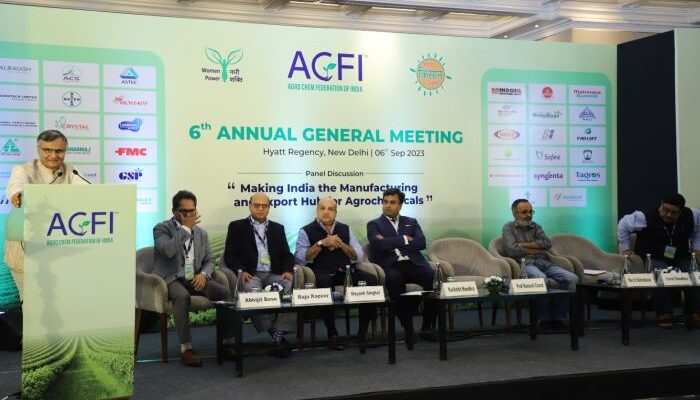Amid easing Chinese competition, Niti Aayog member Professor Ramesh Chand expressed hope that the Indian agrochemical industry may grow at a much higher rate than the current 8-9 per cent clocked in the last 5-6 years.
Speaking at a panel discussion organised by the Agro Chem Federation of India (ACFI) on the occasion of its 6th Annual General Meeting in New Delhi on Wednesday, Professor Ramesh Chand said, “Since 2016, the growth of agrochemical sector has jumped to 8-9 per cent and the industry may be heading to attain 10 per cent growth rate, which is miracle growth rate considering much of this growth rate has happened during the Covid-19 pandemic years when the production activities were seriously disrupted. As the competition from China is unlikely to remain at the level witnessed in the past, the Indian agrochemical industry may grow at a much higher pace, at any rate in the realm of possibility.”
He also called upon the agrochemical industry to use the opportunity to reduce dependence on imports of raw inputs as much as possible.
You may also like to read: Omnivore exits from Barrix Agro Sciences, sells stake to Sumitomo Chemical
As per the figure available in the public domain, India imports agrochemicals including raw materials worth Rs 14,000 crore and exports stand at around Rs 43,000 crore. “This kind of import is not harmful at all, but China’s situation provides a good opportunity to reduce it further,” he said.
He urged the Agro Chem Federation of India (ACFI) to come out with a document on the ease of doing business in agrochemicals and asked the industry to ponder why many Western countries are shifting from agrochemicals to biopesticides.
“I have seen it in many countries. The Netherlands hardly sells any agrochemicals. The entire West is going in that direction. I think in the long run this (Indian) industry is required to pay attention to this aspect. Perhaps the industry needs to move from selling pesticides to pest control and think towards offering solutions like integrated pest management,” he said.
He also advised the Indian industry to conduct business responsibly complying with issues related to ESG (environment, social, and governance) and focus on innovation to minimise pollution.
You may also like to read: FMC India launches ‘Entazia’ biofungicide, a biological solution for crop protection
Also participating in the panel discussion, Parikshit Mundhra, Chairman, ACFI and Managing Director, Willowood Chemicals said, “Our association is committed to work for increasing farmers’ income by offering them high-quality agrochemicals at affordable cost and will look at the valuable suggestion made by Professor Ramesh Chand as well as other stakeholders,”
Abhijit Bose, General Secretary, ACFI and Chief Marketing Officer, Tagros Chemicals India also expressed similar views and has asked the industry to focus on increasing India’s agrochemical production and reducing import dependence.
Earlier, setting the tone for the panel discussion, Director General of ACFI Dr. Kalyan Goswami informed that ACFI is working towards creating a favourable ecosystem for the agrochemicals sector that would facilitate an increase in agrochemical exports, and position India as an attractive destination for foreign investments.
PI Industries Managing Director, Mayank Singhal; FMC India Director, Raju Kapoor and Bayer Crop Science Head of Alternate Business Models, Ajeet Chahal were also present in the panel discussion.





